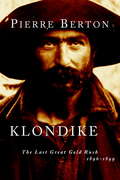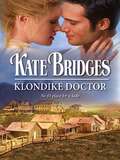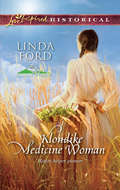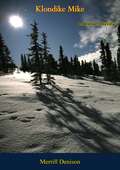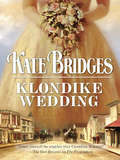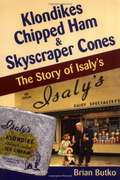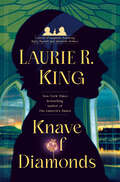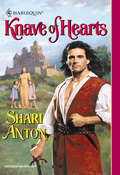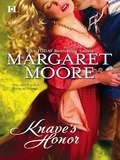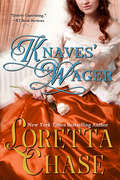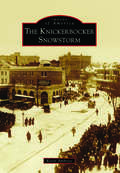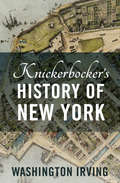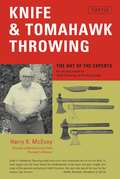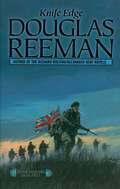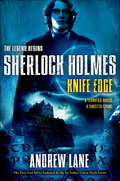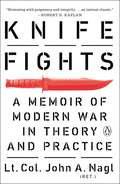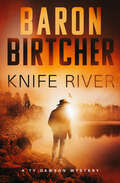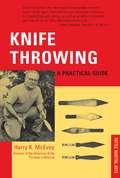- Table View
- List View
Klimawandel und der Untergang von Hochkulturen: Was lehrt uns die Geschichte?
by Gerhard GeroldGlobale Klimaveränderung und Klimakollaps sind in Medien und Gesellschaft ein inzwischen viel beachtetes Thema geworden. Der Zusammenbruch alter Hochkulturen wird dabei in Verbindung mit plötzlichen Klimaveränderungen gebracht. Anhand neuester Forschungsergebnisse gibt das Buch Antworten auf die Rolle von Klimaveränderung für den Kollaps alter Hochkulturen zu unterschiedlichen Zeiten und Kontinenten – von Mesopotamien bis nach Grönland. Dabei erfolgt eine Zusammenschau von archäologischen und paläoklimatischen Erkenntnissen unter Berücksichtigung der damaligen ökonomischen, politischen und religiös-kulturellen Verhältnisse. Der Geograph Gerhard Gerold legt mit diesem Buch eine detaillierte Analyse der schon in historischer Zeit bestehenden komplexen Vernetzung kulturgeschichtlicher und umweltökologischer Bedingungen vor, die für unsere heutige globalisierte Welt eine große Aktualität besitzen. Das Buch bietet zahlreiche Beispiele für den Vergleich damaliger und heutiger Umweltkrisen. Der Autor: Gerhard Gerold gehört als Mitglied der Nationalen Akademie der Wissenschaften Leopoldina zu den Wissenschaftlern, die sich schon seit den 80er Jahren mit Themen der Umweltzerstörung in den Tropen beschäftigt haben. Der Zusammenbruch früher Hochkulturen in Verbindung mit regionalen Klimaänderungen faszinierten ihn im Rahmen seiner umfangreichen geoökologischen Forschungsarbeiten.
Klondike
by Pierre BertonWith the building of the railroad and the settlement of the plains, the North West was opening up. The Klondike stampede was a wild interlude in the epic story of western development, and here are its dramatic tales of hardship, heroism, and villainy. We meet Soapy Smith, dictator of Skagway; Swiftwater Bill Gates, who bathed in champagne; Silent Sam Bonnifield, who lost and won back a hotel in a poker game; and Roddy Connors, who danced away a fortune at a dollar a dance. We meet dance-hall queens, paupers turned millionaires, missionaries and entrepreneurs, and legendary Mounties such as Sam Steele, the Lion of the Yukon.Pierre Berton's riveting account reveals to us the spectacle of the Chilkoot Pass, and the terrors of lesser-known trails through the swamps of British Columbia, across the glaciers of souther Alaska, and up the icy streams of the Mackenzie Mountains. It contrasts the lawless frontier life on the American side of the border to the relative safety of Dawson City. Winner of the Governor General's award for non-fiction, Klondike is authentic history and grand entertainment, and a must-read for anyone interested in the Canadian frontier.From the Trade Paperback edition.
Klondike Doctor
by Kate BridgesDELICATE AND DEMURE, ELIZABETH LANGLEY WAS NOT! Hadn't she defied upper-class conventions to become a doctor? And now a troubling secret would send her north in search of answers and adventure with the exasperating Colt Hunter. Everything he said made her blood boil. . . ;yet everything he was made her heart race!Mountie Sergeant Colt Hunter had sworn to protect, and he'd never met a woman more in need of protection than the headstrong doctor. Why couldn't she understand that the untamed wilderness of the Yukon was no fit place for a genteel lady? Together they traveled a dangerous road where duty warred with passion, and even Colt couldn't foresee which would win out. . . ;.
Klondike Fever
by Kate BridgesSexy Mountie Dylan Wayburn is having a bad day. Disguised as a drifter, he fetches up in the same stagecoach as Lily Cromwell, a beautiful redhead who was once a family servant. She could blow his cover sky-high. Then their stagecoach is held up at gunpoint--because everyone knows that Lily has struck gold. Pretending to be married to search for the gang who've stolen Klondike Lily's fortune leaves Dylan very, very close to the woman he should protect. He'll try and fight the flames of his desire. . . but how can he ignore the full lips begging to be kissed?
Klondike Gold Rush Centennial: Anthology
by Klondike gold Rush Centennial Committee of Washington StateIn celebration of the centennial of the Klondike Gold Rush, old stories of those original stampeders have been brought alive by new pens. The poetry, stories and creative nonfiction in this anthology are the winning entries of the SPECIAL KLONDIKE GOLD RUSH CENTENNIAL LITERARY CONTEST. Their publication is dedicated to the memory of those who participated in that great adventure one hundred years ago. We hope the reader will enjoy these original stories and poems that celebrate the timeless qualities of the human spirit. This connection with those men and women is the legacy that is being recognized and celebrated at this centennial of the Klondike Gold Rush.
Klondike Medicine Woman
by Linda FordDr. Jacob Calloway was the answer to her prayers-whether he liked it or not. Teena Crow is desperate to learn his scientific healing methods to help her people. But Jacob is too suspicious of Teena's native remedies to allow her near Treasure Creek's clinic. So she decides to earn his respect-and teach the good doctor to see beyond surface differences to their common goal. But it's not just Teena's medicines that render Jacob uncomfortable. Her warm gaze and determination dare him to open his heart. But can their fledgling love weather a town's disapproval, or the secrets they both hide?
Klondike Mike: An Alaskan Odyssey
by Merrill DenisonKlondike Mike: An Alaskan Odyssey is Merrill Denison’s 1943 biography of Mike Ambrose Mahoney, a Canadian who travelled to the North in 1897 in search of gold and adventure. In Klondike Mike—a popular “Book of the Month Club” choice—Denison uses imagined omnipotent disclosures of his subject’s thoughts to enrich his writing with a sense of immediacy. In episodic scenes, readers accompany Mahoney through mishaps and adversity: Mahoney hauling a piano on his back up the Chilkoot Pass so that the Sunny Samson Sisters Sextette can get to Dawson to make their fortunes entertaining prospectors; or Mahoney setting a record with his team of dogs as they race across the frozen North from Dawson to Skagway in only fourteen days. The dramatic tension inherent in each of these adventures provides Klondike Mike with a surging narrative pulse and pace—a clever evocation of gold rush fever. In these ways, Klondike Mike demonstrates that Denison should be considered an early innovator of the genre now known as creative non-fiction.Richly illustrated throughout.
Klondike Wedding
by Kate BridgesWRONG GROOM. . . All Genevieve Summerville wants is a good life for herself in the wild Klondike. She agrees to take handsome Canadian Mountie Luke Hunter as a stand-in groom while her fiancé satisfies his gold-fever. But the best-laid plans go awry -- and Genevieve and Luke find themselves legally bound together! RIGHT HUSBAND? Living in close quarters, Genevieve is surprised by Luke's gentleness. And as his kisses awaken her most secret desires, Genevieve must choose between the life she wanted and the longings of her heart. . .
Klondikes, Chipped Ham, & Skyscraper Cones
by Brian ButkoThe Klondike bar is America's favorite ice cream novelty. This book traces its history and the rise and fall of its creator company, Isaly's Dairy, which evolved from one milk wagon to a dozen plants that supplied its 400 delis and dairies by the 1950s.
Knave of Diamonds: A novel of suspense featuring Mary Russell and Sherlock Holmes
by Laurie R. KingMary Russell&’s allegiances are tested by the reappearance of her long-lost uncle—and a tantalizing case not even Sherlock Holmes could solve.When Mary Russell was a child, she adored her black sheep Uncle Jake. But she hasn&’t heard from him in many years, and she assumed that his ne&’er-do-well ways had brought him to a bad end somewhere—until he presents himself at her Sussex door. Yes, Jake is back, and with a load of problems for his clever niece. Not the least of which is the reason the family rejected him in the first place: He was involved—somehow—in the infamous disappearance of the Irish Crown Jewels from an impregnable safe in Dublin Castle.It was a theft that shook a government, enraged a king, threatened the English establishment—and baffled not only the Dublin police and Scotland Yard, but Sherlock Holmes himself. And, now, Jake expects Russell to step into the middle of it all? To slip away with him, not telling Holmes what she&’s up to? Knowing that the theft—unsolved, hushed-up, scandalous—must have involved Mycroft Holmes as well?Naturally, she can do nothing of the sort. Siding with her uncle, even briefly, could only place her in opposition to both her husband-partner and his secretive and powerful brother. She has to tell Jake no.On the other hand, this is Jake—her father&’s kid brother, her childhood hero, the beloved and long-lost survivor of a much-diminished family.Conflicting loyalties and international secrets, blatant lies and blithe deceptions: sounds like another case for Mary Russell and Sherlock Holmes.
Knave of Hearts
by Shari Anton'Twas Time To Take A Wife-Whether He Wanted To Or Not!Stephen of Wilmont little desired a life bound to castle keep and crops, but, knowing his duty, marry he would. Yet when Fate reunited him with the proud and peerless Marian de Lacy, his first and fiercest love, he suspected his wandering days just might be over...!Her Daughters Were Her Joy, Their Heritage Her SecretBut, Marian de Lacy realized, honor demanded the truth be told, for Stephen, knight errant of Wilmont and mirror of her soul, had returned to reignite their passion's flame...!
Knave's Honor
by Margaret MooreHis arrow strikes true...bringing Lady Elizabeth d'Averette face-to-face with the decidedly intriguing Finn--an outlaw with more honor than most knights. When he saves her from unspeakable violence, she agrees to reward his valorous actions. But would sharing his bed--however chastely--prove too high a price to pay?Finn values courage, a quality Lizette displays in abundance. She joins him in a dangerous subterfuge to rescue his brother and expose the long-held secrets of the royal court, her adventurous spirit seeming to be a true match to his own. But could a noble beauty really care for a common son of the hills of Eire?
Knaves' Wager
by Loretta ChaseThe traditional English Regency from New York Times bestselling author, Loretta Chase, is back...Lilith Davenant, has ample reason to detest Julian Wyndhurst, Marquess of Brandon: he's exactly the kind of man who hastened the demise of her profligate husband, and the debt he owed to Julian has forced her to an engagement with a wealthy suitor for the sake of supporting her beloved nieces and nephews. Besides that, Lord Julian somehow manages to ignite disturbing... feelings ... she's never felt before!Lord Julian used his considerable skills and cunning in the war against Napoleon. Now he's obliged to use the same talents to save his young cousin from a disastrous marriage to a scheming mistress -- who makes him a wager: If Julian can seduce the famously icy Lady Lilith Davenant, the lady will release his cousin from the engagement.But very quickly, Julian discovers Lilith's hidden warmth, kindness and humor. Will he be able to prove his heart to her before she learns of his recklessly shameless wager?
Kneelers: The Unsung Folk Art of England and Wales
by Elizabeth BinghamA charming and witty history of the quirky - but surprisingly widespread - craft of embroidering kneeler cushions. The perfect gift book this Christmas, for those who love kneelers and those who don't!'A lovely look at a not-quite-vanishing craft that lies, literally, below our knees ... Inventive and interesting' The Oldie, 'Best Reads for All Ages This Christmas''A treasure of a collection' Amber Butchart, of BBC's The Great British Sewing Bee'I think I may already have discovered the best non fiction book of 2023' Reverend Richard Coles, author of A Murder Before EvensongKneelers is a celebration of the most widely practised - but often overlooked - folk art in England and Wales over the past ninety years: the design and craft of church kneelers. Featuring charming stories and enchanting designs from churches across the country, the book traces the history of kneelers; from their spectacular beginnings at Winchester in the 1930s to their booming popularity after Queen Elizabeth II's coronation and the present-day congregations who are keeping the tradition alive.In their range and diversity, the kneelers collected here form a fascinating social record of the concerns and interests that occupied their makers - including local fauna and flora, cricket, dragons, post-war tributes and the thrills of high-speed travel.Filled to the brim with beautiful full-colour images, Kneelers displays the quirky artistry and widely varied (and often surprising) motifs which have characterised church kneelers in the twentieth century. It rejoices in the personal stories of some of the people who have practised and advanced the art form, and is a wonderful commemoration of what happens when communities come together to celebrate their history and their environment.'A glorious and delightful salute' Tracy Chevalier, author of A Single Thread'This book is a Godsend!' Alan Titchmarsh, author of The Gardener's Almanac
Knickerbocker Snowstorm, The (Images of America)
by Kevin AmbroseOn the evening of January 28, 1922, several hundred people fought their way through the greatest snowstorm in Washington's history to see a show at the Knickerbocker Theater, the city's largest and most modern moving picture theater of the time. Unbeknownst to the theater patrons, the Knickerbocker Theater's flat roof was tremendously burdened by the weight of the snow. During the show's intermission, the snow-covered roof crashed down upon the crowd. As the roof fell, it collapsed the theater's balcony and pulled down portions of the surrounding brick walls, killing 98 people and injuring 133. Some of Washington's prominent politicians and business owners were among the casualties. The disaster ranks as one of Washington's worst in history, and the snowstorm continues to hold the record for Washington's single greatest snowfall.
Knickerbocker's History of New York: Complete
by Washington IrvingThis nineteenth-century novel by the author of Rip Van Winkle offers a satirical history of New York, from the creation of the world to the fall of New Amsterdam.Washington Irving&’s debut novel, Knickerbocker&’s History of New York was an immediate sensation when it was first published in 1809. Posing as the work of a fictional Dutch historian named Dietrich Knickerbocker, it both catapulted Irving&’s literary reputation and established the &“Father Knickerbocker&” character as a popular icon of New York. Knickerbocker discusses the development of New Netherland, the seventeenth-century Dutch colony, with a special focus on New Amsterdam, the settlement located on present-day Manhattan. The thoroughly tongue-in-cheek chronicle contains &“among many surprising and curious matters, the unutterable ponderings of Walter the Doubter, the disastrous projects of William the Testy, and the chivalric achievements of Peter [Stuyvesant] the Headstrong.&”
Knife & Tomahawk Throwing
by Harry K. McevoyHarry McEvoy, foremost expert in the field of knife and tomahawk throwing and best-selling author of Knife Throwing: A Practical Guide, provides us with an exciting, in-depth look at the popular sport of weapon throwing.Meet the men who will through a flaming knife at a lovely lady on a spinning target-and not scorch a hair; learn about the legendary "Skeeter" Vaughan, whose record-breaking throw saved the lives of hundreds of U.S. servicemen during World War II; and witness the courage of Tony Cascarella, who brought down a 275-pound wild boar with only three Bowie-Axe throwing knives.In addition, this book will clearly show you the skills involved in knife and tomahawk throwing-skills all the professionals first mastered before attempting the daring feats required when performing the "impalement arts." Also presented is an interesting history of throwing-knives, from the earliest times, through the development of the European daggers, and up tot the knives used during the Vietnam War. Furthermore, you'll learn about many of the other throwing instruments of the world, including the martial arts weapons used by the ninja of Japan, and the deadly boomerangs of the Australian aborigines.Concisely written and illustrated with more than 50 photographs (including many of the "greats" in action), Knife and Tomahawk Throwing is a must for anyone interested in these fascinating sports.
Knife & Tomahawk Throwing
by Harry K. McevoyHarry McEvoy, foremost expert in the field of knife and tomahawk throwing and best-selling author of Knife Throwing: A Practical Guide, provides us with an exciting, in-depth look at the popular sport of weapon throwing.Meet the men who will through a flaming knife at a lovely lady on a spinning target-and not scorch a hair; learn about the legendary "Skeeter" Vaughan, whose record-breaking throw saved the lives of hundreds of U.S. servicemen during World War II; and witness the courage of Tony Cascarella, who brought down a 275-pound wild boar with only three Bowie-Axe throwing knives.In addition, this book will clearly show you the skills involved in knife and tomahawk throwing-skills all the professionals first mastered before attempting the daring feats required when performing the "impalement arts." Also presented is an interesting history of throwing-knives, from the earliest times, through the development of the European daggers, and up tot the knives used during the Vietnam War. Furthermore, you'll learn about many of the other throwing instruments of the world, including the martial arts weapons used by the ninja of Japan, and the deadly boomerangs of the Australian aborigines.Concisely written and illustrated with more than 50 photographs (including many of the "greats" in action), Knife and Tomahawk Throwing is a must for anyone interested in these fascinating sports.
Knife & Tomahawk Throwing
by Harry K. McevoyHarry McEvoy, foremost expert in the field of knife and tomahawk throwing and best-selling author of Knife Throwing: A Practical Guide, provides us with an exciting, in-depth look at the popular sport of weapon throwing.Meet the men who will through a flaming knife at a lovely lady on a spinning target-and not scorch a hair; learn about the legendary "Skeeter" Vaughan, whose record-breaking throw saved the lives of hundreds of U.S. servicemen during World War II; and witness the courage of Tony Cascarella, who brought down a 275-pound wild boar with only three Bowie-Axe throwing knives.In addition, this book will clearly show you the skills involved in knife and tomahawk throwing-skills all the professionals first mastered before attempting the daring feats required when performing the "impalement arts." Also presented is an interesting history of throwing-knives, from the earliest times, through the development of the European daggers, and up tot the knives used during the Vietnam War. Furthermore, you'll learn about many of the other throwing instruments of the world, including the martial arts weapons used by the ninja of Japan, and the deadly boomerangs of the Australian aborigines.Concisely written and illustrated with more than 50 photographs (including many of the "greats" in action), Knife and Tomahawk Throwing is a must for anyone interested in these fascinating sports.
Knife Edge
by Douglas ReemanAfter the murder of his father, Lieutenant-Colonel Mike Blackwood, Ross Blackwood finds himself assigned to the Far East, taking on rebels and illegal-arms dealers in Hong Kong and Malaysia. Along the way he meets another Blackwood, his cousin Steve, who has made a life for himself in the Corp, as an explosives expert. The two Blackwoods uphold the honor of their family and their chosen profession while negotiating the fallout of Britain's post-colonial politics.
Knife Edge (Sherlock Holmes: The Legend Begins)
by Andrew LaneTeen Sherlock battles a monstrous adversary on a mission to Ireland with his brilliant brother, Mycroft. Young Sherlock is thrown into a tangled web involving a spiritualist whose powers have attracted the attention of governments around the world. At the castle where the medium is demonstrating his "gift," Sherlock finds a household in turmoil. Servants and some of the guests are frightened but who--or what?--has terrified them so much that nobody will speak out? Young Sherlock must bring all his powers of deduction to bear in unraveling his greatest mystery yet.Sherlock Holmes: Think you know him? Think again.
Knife Fights
by John A. NaglFrom one of the most important army officers of his generation, a memoir of the revolution in warfare he helped lead, in combat and in WashingtonWhen John Nagl was an army tank commander in the first Gulf War of 1991, fresh out of West Point and Oxford, he could already see that America's military superiority meant that the age of conventional combat was nearing an end. Nagl was an early convert to the view that America's greatest future threats would come from asymmetric warfare--guerrillas, terrorists, and insurgents. But that made him an outsider within the army; and as if to double down on his dissidence, he scorned the conventional path to a general's stars and got the military to send him back to Oxford to study the history of counterinsurgency in earnest, searching for guideposts for America. The result would become the bible of the counterinsurgency movement, a book called Learning to Eat Soup with a Knife.But it would take the events of 9/11 and the botched aftermath of the Iraq invasion to give counterinsurgency urgent contemporary relevance. John Nagl's ideas finally met their war. But even as his book began ricocheting around the Pentagon, Nagl, now operations officer of a tank battalion of the 1st Infantry Division, deployed to a particularly unsettled quadrant of Iraq. Here theory met practice, violently. No one knew how messy even the most successful counterinsurgency campaign is better than Nagl, and his experience in Anbar Province cemented his view. After a year's hard fighting, Nagl was sent to the Pentagon to work for Deputy Secretary of Defense Paul Wolfowitz, where he was tapped by General David Petraeus to coauthor the new army and marine counterinsurgency field manual, rewriting core army doctrine in the middle of two bloody land wars and helping the new ideas win acceptance in one of the planet's most conservative bureaucracies. That doctrine changed the course of two wars and the thinking of an army.Nagl is not blind to the costs or consequences of counterinsurgency, a policy he compared to "eating soup with a knife." The men who died under his command in Iraq will haunt him to his grave. When it comes to war, there are only bad choices; the question is only which ones are better and which worse. Nagl's memoir is a profound education in modern war--in theory, in practice, and in the often tortured relationship between the two. It is essential reading for anyone who cares about the fate of America's soldiers and the purposes for which their lives are put at risk.
Knife Fights
by John A. NaglFrom one of the most important army officers of his generation, a memoir of the revolution in warfare he helped lead, in combat and in WashingtonWhen John Nagl was an army tank commander in the first Gulf War of 1991, fresh out of West Point and Oxford, he could already see that America's military superiority meant that the age of conventional combat was nearing an end. Nagl was an early convert to the view that America's greatest future threats would come from asymmetric warfare--guerrillas, terrorists, and insurgents. But that made him an outsider within the army; and as if to double down on his dissidence, he scorned the conventional path to a general's stars and got the military to send him back to Oxford to study the history of counterinsurgency in earnest, searching for guideposts for America. The result would become the bible of the counterinsurgency movement, a book called Learning to Eat Soup with a Knife.But it would take the events of 9/11 and the botched aftermath of the Iraq invasion to give counterinsurgency urgent contemporary relevance. John Nagl's ideas finally met their war. But even as his book began ricocheting around the Pentagon, Nagl, now operations officer of a tank battalion of the 1st Infantry Division, deployed to a particularly unsettled quadrant of Iraq. Here theory met practice, violently. No one knew how messy even the most successful counterinsurgency campaign is better than Nagl, and his experience in Anbar Province cemented his view. After a year's hard fighting, Nagl was sent to the Pentagon to work for Deputy Secretary of Defense Paul Wolfowitz, where he was tapped by General David Petraeus to coauthor the new army and marine counterinsurgency field manual, rewriting core army doctrine in the middle of two bloody land wars and helping the new ideas win acceptance in one of the planet's most conservative bureaucracies. That doctrine changed the course of two wars and the thinking of an army.Nagl is not blind to the costs or consequences of counterinsurgency, a policy he compared to "eating soup with a knife." The men who died under his command in Iraq will haunt him to his grave. When it comes to war, there are only bad choices; the question is only which ones are better and which worse. Nagl's memoir is a profound education in modern war--in theory, in practice, and in the often tortured relationship between the two. It is essential reading for anyone who cares about the fate of America's soldiers and the purposes for which their lives are put at risk.
Knife River (The Ty Dawson Mysteries)
by Baron BirtcherA sheriff fighting to keep the peace in 1970s Oregon faces a shocking secret from his town&’s past, in this crime thriller from the author of Reckoning. There are rules in the West no matter what era you were born in, and it&’s up to lawman Ty Dawson to make sure they&’re followed in the valley he calls home. The people living on this unforgiving land keep to themselves and are wary of the modern world&’s encroachment into their quiet lives. So it&’s not without some suspicion that Dawson confronts a newcomer to the region: a record producer who has built a music studio in an isolated compound. His latest project is a collaboration with a famous young rock star named Ian Swann, recording and filming his sessions for a movie. An amphitheater for a live show is being built on the land, giving Dawson flashbacks to the violent Altamont concert. Not on his watch. But even beefed up security can&’t stop a disaster that&’s been over a decade in the making. All it takes is one horrific case bleeding its way into the present to prove that the good ol&’ days spawned a brand of evil no one wants to revisit . . .Praise for the Ty Dawson Mysteries &“The novel combines the mystery and honesty of Craig Johnson&’s Longmire with the first-person narration of a fiercely independent Oregon character.&” —Sheila Deeth, author of John&’s Joy &“A masterful work of a time gone by. . . . Ty Dawson is a cowboy, lawman, father and philosopher like none other.&” —Neal Griffin, Los Angeles Times–bestselling author of The Burden of Proof
Knife Throwing
by Harry K. McevoyA concise, informative book on "the sport of the pioneers". Knife Throwing includes beginning and advanced throwing techniques and covers everything from home practice to hunting methods with accurate instructions. Readers will learn how to hurl hatches, tomahawks, the Gurkha Kukri, Bowies, and other knives.

